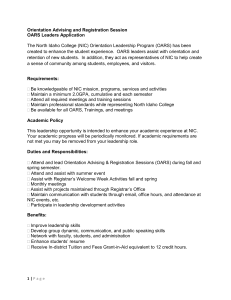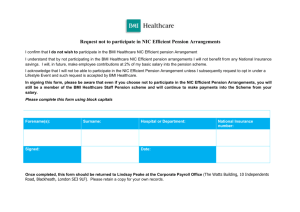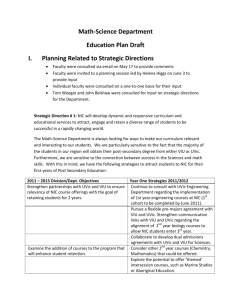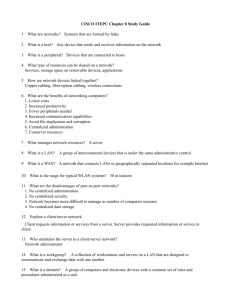e-Public Distribution Monitoring system (e-PDMS)
advertisement
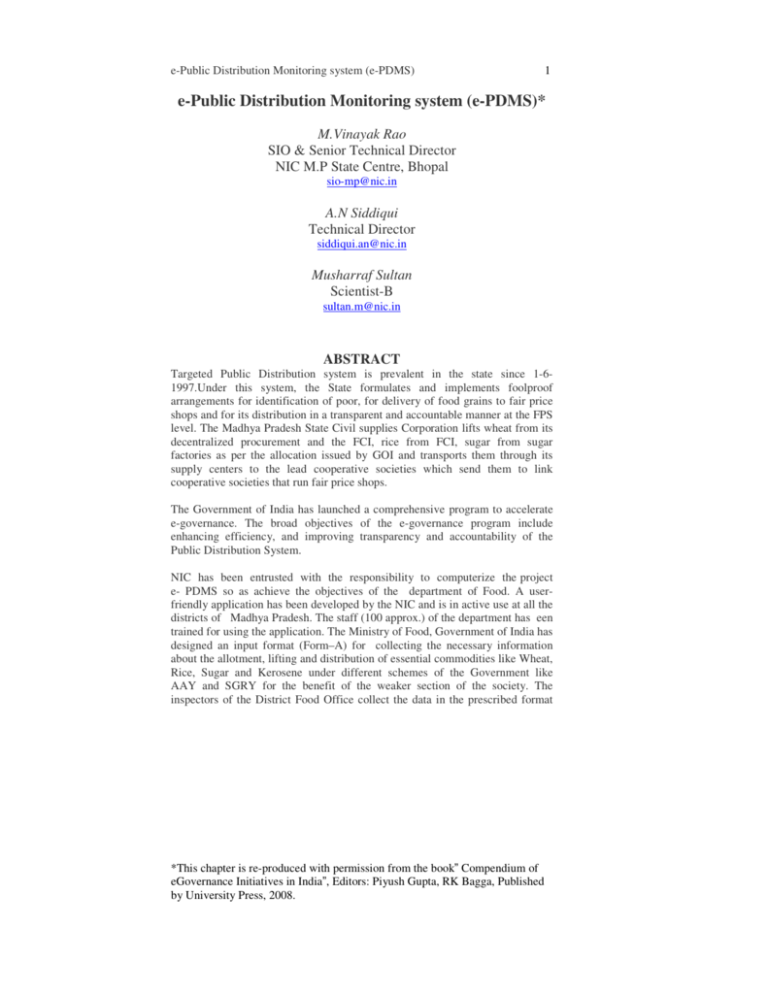
e-Public Distribution Monitoring system (e-PDMS) 1 e-Public Distribution Monitoring system (e-PDMS)* M.Vinayak Rao SIO & Senior Technical Director NIC M.P State Centre, Bhopal sio-mp@nic.in A.N Siddiqui Technical Director siddiqui.an@nic.in Musharraf Sultan Scientist-B sultan.m@nic.in ABSTRACT Targeted Public Distribution system is prevalent in the state since 1-61997.Under this system, the State formulates and implements foolproof arrangements for identification of poor, for delivery of food grains to fair price shops and for its distribution in a transparent and accountable manner at the FPS level. The Madhya Pradesh State Civil supplies Corporation lifts wheat from its decentralized procurement and the FCI, rice from FCI, sugar from sugar factories as per the allocation issued by GOI and transports them through its supply centers to the lead cooperative societies which send them to link cooperative societies that run fair price shops. The Government of India has launched a comprehensive program to accelerate e-governance. The broad objectives of the e-governance program include enhancing efficiency, and improving transparency and accountability of the Public Distribution System. NIC has been entrusted with the responsibility to computerize the project e- PDMS so as achieve the objectives of the department of Food. A userfriendly application has been developed by the NIC and is in active use at all the districts of Madhya Pradesh. The staff (100 approx.) of the department has een trained for using the application. The Ministry of Food, Government of India has designed an input format (Form–A) for collecting the necessary information about the allotment, lifting and distribution of essential commodities like Wheat, Rice, Sugar and Kerosene under different schemes of the Government like AAY and SGRY for the benefit of the weaker section of the society. The inspectors of the District Food Office collect the data in the prescribed format *This chapter is re-produced with permission from the book” Compendium of eGovernance Initiatives in India”, Editors: Piyush Gupta, RK Bagga, Published by University Press, 2008. e-Public Distribution Monitoring system (e-PDMS) 2 and brings them to the district for the data entry and report generation. The data entry module of the designed software facilitate the data entry scheme-wise. A weekly monitoring of the project is done by the senior officers of Food department with officials of the districts, face–to–face through the powerful Video conferencing studios located in each of the NIC district Centre. In addition to it, a web-based on–line monitoring system http://www.mp.gov.in/mpfood/fpsmon has also been developed to display many important reports like FPS-wise, Block-wise stock, allotment, lifting and distribution of food grains based on data received from district Food Offices to the web– server located at the state level. This facilitates the online monitoring of PDS scheme through internet. 1. Introduction/Background Project conceptualization Pre project -state The existing system was completely manual. The Department of Food, Civil Supplies & Consumer Protection has over 20,000 Fair Price shops (FPS) spread across Madhya Pradesh. Ration Card Holders take their ration supply from these FPS. The manual system was unable to cope up with information requirement of the department and shorts supply of essential commodities was common causing severe problem for the people especially living below the poverty line. Post project state *This chapter is re-produced with permission from the book” Compendium of eGovernance Initiatives in India”, Editors: Piyush Gupta, RK Bagga, Published by University Press, 2008. e-Public Distribution Monitoring system (e-PDMS) • • • • • • • 3 The officers of the department having access to the first hand information on their desktop which help quick and accurate information retrieval about availability of essential commodities Effective monitoring in equitable distribution of essential commodities to FPS Tightening the noose on the defaulters Quick and accurate information for better strategic planning for administration Control/elimination of malpractices in the distribution of essential commodities It has replication potential throughout the country as well as other developing countries Faster communication between headquarters and district level offices. 2. Project Vision, stakeholders, objectives and services Vision • To uplift the below poverty line and destitute population • To cover the whole Food supply chain under PDS like FCI, State Civil Supplies Corporation and State Warehousing Corporation and lead societies • To publish detail of more than 1.5 Crore Ration Card holders along with photograph and thumb impression on web server Stake Holders Internal Various departments of State Government External NGOs, Media and Citizens Objective To help the Govt. in effective monitoring of PDS scheme To bring transparency in the PDS scheme To provide fast and accurate information to the Govt. for strategic decisions Services *This chapter is re-produced with permission from the book” Compendium of eGovernance Initiatives in India”, Editors: Piyush Gupta, RK Bagga, Published by University Press, 2008. e-Public Distribution Monitoring system (e-PDMS) 4 A. Government to Citizen (G2C) G2C aims at connecting the Government to Citizens by informing the public about the supporting accountability of the Government as well as its rationale to increase the pressure on the Government officials to perform well and to improve the public understanding. The monthly progress reports received from the district level offices through NIC Network (NICNET) are consolidated at the state level which helps them in decision making and monitoring of the essential commodities to the citizens through various Fair price shops in the entire state of Madhya Pradesh. Hence, the project helps in providing better services to the citizens as well as in the planning and effective management for the PDS scheme. Thus it meets the expectations of citizens with respect to proper distribution of essential commodities. B. Consumer to Government. (C2G): C2G constitute the area where the citizens directly interact with the Government. Citizens feedback is a must for improving the Government services and unless the Government responds to the citizens, it remains a distant dreams for the Government to know what exactly needs to be planned. The Video conferencing facility made available by the NIC is a mile stone in achieving this objectives as the citizens can participate in the conference through their elected representatives who are said to be the voice of the citizens. 3. Public Private Partnership (PPP) - roles and responsibilities, audit, SLA, business model; If not PPP, funding process Roles and responsibilities The project has been designed and developed by NIC M.P state centre. Maintenance and technical support regarding e-PDMS is provided by NIC at state level as well at district level by District Informatics Officers at all 48 locations of M.P. Data entry/Updation is the responsibility of the staff of Department of Food, Civil Supplies and Consumer Protection. All the necessary technical support including NIC district centre resources are provided to user department. *This chapter is re-produced with permission from the book” Compendium of eGovernance Initiatives in India”, Editors: Piyush Gupta, RK Bagga, Published by University Press, 2008. e-Public Distribution Monitoring system (e-PDMS) 5 Business model The project has been started using two-tier client server architecture. Then offline application has been developed and data from all 48 locations consolidated and transmitted to web-server. This model has the problem of delay in transmission and manual intervention later model has been replaced by web-enabled system using dot net technology. Funding process The project has been done free of charge from development to implementation by NIC. Existing resources of department of food have been used. NIC resources at state centre like IDC, NICNET and district centers have been used. VC of NIC has been used for monitoring. Hence no funding is required. 4. Necessity/Needs Implementation of PDS scheme was not proper by using manual system due to lack of Man power in the department of Food, Civil Supplies and Consumer protection 5. Project plan Requirements of process re-engineering and Legal framework Technology Architecture To implement the PDS system effectively the process reengineering was done. The existing system was completely manual. The information collection was time taking. Redundancy and inaccuracy was a common problem. To overcome these problems the entire process was re-engineered by designing a Performa Called Form-A with the help of the department of Food, Civil supplies and consumer protection. Form-A contains the information opening stock, allocation, lifting, distribution and closing stock of all commodities as well the numbers of ration cards of all categories were collected by food inspectors from fair price shops. With these minimum inputs maximum reports, queries and analysis is done to satisfy the needs of the user. *This chapter is re-produced with permission from the book” Compendium of eGovernance Initiatives in India”, Editors: Piyush Gupta, RK Bagga, Published by University Press, 2008. e-Public Distribution Monitoring system (e-PDMS) 6 Initially Client Server two-tier architecture was followed .However the system needed a lot of manual intervention for data transmission, consolidation and website replication. Later these problems were removed by re-engineering the process using multi tier architecture (web-enabled) with help Microsoft. NET Framework. 6. Milestones a. Project Proposal b. SRS c. Coding d. Implementation 7. Project Management Structure a. Technical Director b. Principal Systems Analyst c. Systems Analyst 8. Implementation 9. Strategy for Pilot to roll out d. Following is the strategy for implementation in M.P e. Used Existing infrastructure of District Supply offices f. Training of Staff of Directorate and District Supply offices g. Offline Pilot Implementation in 4 Districts h. Offline Implementation in all Districts of Madhya Pradesh i. Online Pilot Implementation in 4 Districts j. Online Implementation in all Districts of Madhya Pradesh k. Service and support at all 48 district locations by NIC professionals. 10. Capacity building: Governance structure, Project management teams, Exit management team, Change management and training Governance structure a. Principal Secretary b. Commissioner (Food) c. District Food Officers d. Food Inspectors *This chapter is re-produced with permission from the book” Compendium of eGovernance Initiatives in India”, Editors: Piyush Gupta, RK Bagga, Published by University Press, 2008. e-Public Distribution Monitoring system (e-PDMS) 7 Project management teams • State Informatics Officer (SIO), NIC • Technical Director, NIC • Principal Systems Analyst, NIC • Systems Analyst • District Informatics Officers Change management and training • Technical Director, NIC • Principal Systems Analyst, NIC • Systems Analyst Training Imparted training to nominated staff of all 48 district Food offices and Directorate on Computer Awareness and ePDMS. 11. Evaluation and Measurement Review through weekly video conferencing with District Food Officers regarding project implementation 12. Issues and their solutions Lessons learnt - critical success factors, failure factors • Proper Human Resource Development • Proper infrastructure and connectivity • Linkage with the e-Ration Card Management System has the following advantages: – Citizen Data base Preparation – Social Security and Old age Pensioners Database – LPG Connection Holders Database – Land Holdings Details – Identification of BPL and AAY families – elimination of Bogus Ration Cards • Replication in other states It can be replicated not only to all the states of our country but also to the developing and under developed countries where the Government runs such schemes for the financially and socially backward community. *This chapter is re-produced with permission from the book” Compendium of eGovernance Initiatives in India”, Editors: Piyush Gupta, RK Bagga, Published by University Press, 2008. e-Public Distribution Monitoring system (e-PDMS) 8 We are in the process of replicating it throughout the country. • Road ahead • Enrichment of FPS database • Addition of Transaction of Lead Societies and FCI • Linkage with the e-Ration Card Management System 13. Status and results Present status • Web-enabled system • Availability of data of 20,000 Fair Price Shops since 2005 14. Specific achievements during the year 2006-07 • Conversion from offline system to online system • Expenditure in monitoring i.e. on telephone, fax and travelling has been reduced • Information dissemination- data of fair price shop is available on the net and is accessible to all 15. Future plans for readers seeking more information on project • To cover the whole Food supply chain under PDS like FCI, State Civil Supplies Corporation and State Warehousing Corporation and lead societies • To publish detail of more than 1.5 Crore Ration Card holders along with photograph and thumb impression on web server • To generate Electronic Ration Cards for all Ration Card Holders • SMS based information regarding Fair Price Shop (FPS) details *** *This chapter is re-produced with permission from the book” Compendium of eGovernance Initiatives in India”, Editors: Piyush Gupta, RK Bagga, Published by University Press, 2008.



